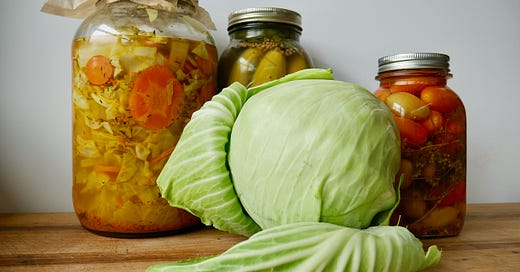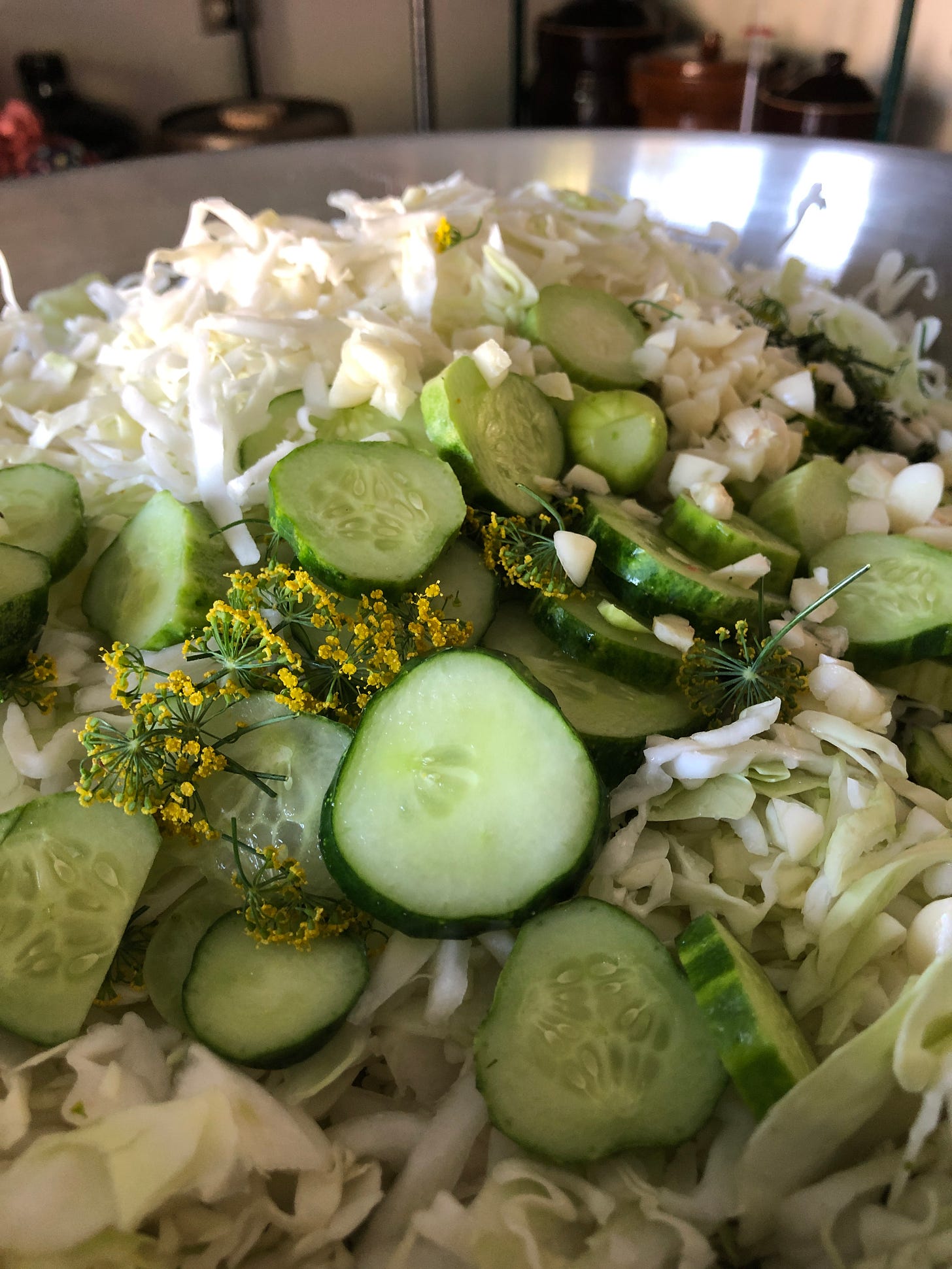This past summer you might remember reading different reports or seeing coverage on the news channels about a link between fermented foods and COVID-19. I will refrain from saying that the news went, well, you know, vi**l. Interestingly enough it seemed to mutate (sorry) to strong evidence for kimchi consumption, which is interesting given the source of the study, more on that in a moment.
So now more than a year into this COVID-19 SARS-CoV-2 experience I thought it would be a good time to look at the original concept paper and the hypothesis and see what we has been learned in the past 10 months since the original paper and data.
Just a reminder: I'm not a scientist and I'm not a nutritionist. I'm just a cookbook author that loves science. My goal is simply lucidity from and for the laity. To that end there will be numbers in this post, there just isn’t a lot of analogy opportunities and given the gravity of COVID-19 SARS-CoV-2 I wanted to treat it with care. So no zombie postbiotics like the last post.
As a thank you for sticking it out all the way through I’m including a recipe for Pickle Kraut, which has never appeared in any of our fermentation cookbooks. You’ll see why this recipe represents the recipe you should be making right now for you and your family. Okay, enough preamble, let’s dive into the research.
The title of the concept paper1 published May 27th, 2020 is "Is diet partly responsible for differences in COVID-19 death rates between and within countries?" and in it the authors looked at the death rates per million people in the European countries. What the data from the CDC showed way back April 17th was that deaths per million ranged from 1.65 in Slovakia to 445.48 in Belgium. I pulled the same data, take a look below. I notice roughly half the countries fall between Slovakia at 1.65 and Portugal at 64.43. Then we double to Sweden at 138.62, another 15 for Switzerland then big jumps to the U.K, France, Italy, Spain and finally Belgium. For reference the United States then was at 116.84, below Sweden. The question this data begs is why the differences?
The authors acknowledge that while measuring mortality is one of the best ways to measure the burden of COVID-19 upon a society the many reporting biases between countries and within countries makes it less than perfect. Still, with that in mind, they ask if diet could be a factor in explaining such differences in mortality rates. They then did two ecological studies, one looking at the consumption of vegetables2 and another looking at the consumption of fermented vegetables3.
At this point the latest data is from July 18th and they reported mortality data globally, but given their ecological studies were in Europe I pulled a report as of that date for the same countries below to keep it straight in my head. As you can see it shows roughly the same order with Belgium continuing to distance itself from all other countries. If you are wondering if the United States was on here it would be at 426.19, just below France.
So, let's look at these two studies. The veggie study analyzed cruciferous vegetables (broccoli, cauliflower, head cabbage and leafy brassica) as well as spinach, cucumber, courgetti (zucchini), lettuce and tomato. Of these cabbage and cucumber were the only vegetables that passed the statistical significance line. It could be telling that I can't write cabbage without thinking of it as sauerkraut or cucumber without wanting to correct to pickle. Hold that thought...
The second study looked at a number of fermented foods, including fermented vegetables, marinated/pickled vegetables, fermented milk, yoghurt and fermented sour milk. Right off I wanted to know what the definition of marinated/pickled vegetables was and how it differed from fermented vegetables. Both studies utilized the European Food Safety Authority (EFSA) Comprehensive European Food Consumption Database (https://www.efsa.europa.eu/en/food-consumption/comprehensive-database) so I checked it out. In the references the FoodEx2 code for Processed or preserved vegetables breaks out fermented/pickled/marinated vegetables into fermented vegetables and marinated/pickled vegetables, with the latter appearing to be utilizing "pickling/marinating with acid/salt solution and eventual canning or packing" which sounds like it likely is vinegar-based, but I'm not positive.
What they found surprised the researchers4. Only fermented vegetables crossed that statistical significance line, with a p-value of 0.016. We aren't talking about eating a jar of sauerkraut or pickles either. For each gram per day (less than .04 ounces) of fermented vegetables consumed the mortality risk of COVID-19 decreased by 35.4 percent. There was no statistical significance on percentage change for the marinated/pickled vegetables or the probiotic milk. There was no correlation with fermented sour milk and yoghurt.
The authors are very clear in these papers that they are not proposing causality. As they state in the fermented vegetables paper:
“As in any ecological study, any inference from the observed association should be made at the country level, as the possibility of ecological fallacy precludes inferences at the individual level. Further testing in properly designed individual studies would be of interest. Moreover, associations do not mean causality, and patterns of food consumption can be proxy for other undetermined factors.”
The lead researcher, Dr. Jean Bousquet, Honorary Professor of Pulmonary Medicine at Montepellier University in France has spent some time making the rounds explaining this over and over in interviews about their research. None-the-less, like the classic telephone game, by the end of the summer it starts to get a little wonky when trying to figure out what research is being cited by articles. Tantalizing headlines abound like Can Kimchi Protect You From COVID-19 or Coronavirus: eating more cabbage and cucumber might reduce death rate, European study says, which just referenced the vegetable study. Still, it brought out some of the more interesting findings for the vegetables, like Latvia with the lowest mortality rate also ate a whole lot of cabbage compared to all the other countries, 30 grams (1.1 ounces) daily. The cucumbers consumed by people in Cyprus was that same 30 grams and their mortality was on par with Latvia. Hmmm, cabbage and pickles. That might come around later. They also noted some surprising things, like lettuce. Countries with high rates of lettuce consumption also had high mortality rates. By the way, lettuce does not ferment well so that’s not going to help its cause in this case.
I haven’t found any papers describing clinical trials researching kimchi and COVID-19 prevention yet, nor sauerkraut, nor any fermented foods for that matter. The hypothesis that the differences in COVID-19 mortality rates between countries and within countries may partly be explained by diet, including certain vegetables with potent antioxidants and in fermented form, is just too important to the world right now to not follow up with clinical and observational studies.
In the cabbage and fermented vegetables paper there was discussion about the length of the typical food supply chains around the world and possible impact those may have in increased metabolic syndrome and insulin resistance, leading to the hypothesis that shorter supply chains and traditional groceries may support better tolerance for COVID-19, which might explain the differences in mortality rates between northern and southern Italy for example. That might be an interesting topic to tackle in a future post don’t you think?

There was so also something that surprised me, described as the COVID-19 slum paradox. It was feared that the virus would burn through low-income settlements around the world with unstoppable veracity, but that doesn’t seem to have been the case, at least as of July when data was pulled from a report from the Municipal Corporation of Greater Mumbai5. What they found in a serological survey was that 16% had sero-prevalence (SARS-CoV-2 antibodies) while a whopping 57% had them in the slums. Moreover, the mortality rate in the slum areas was just 0.05% to 0.1%. There is anecdotal evidence offered that this is not unique to Mumbai, nor Indian slums in general. The authors offer that a slum population skewed young may be a factor as well as a high percentage eating traditional, simple fermented foods.
So here are my takeaways from these papers:
It started with an observation that there were large differences both between European countries and within those same countries. Looking at possible explanations diet was explored. I love that there is a database like EFSA with that level of data on food consumption. I wonder if anyone knows of similar resources in the Americas, Africa, Asia Pacific or the Americas?
I think it is great when research reports all the findings. These papers could have limited the results to what garnered the prerequisite p-value but they gave us all of them and I always feel that gives me more trust in the work. We see that fermented cabbage and cucumbers, in both their raw and naturally fermented forms, have statistical significance and that my friends, is why you have a recipe for them to follow.
I still have a lot of learning to do to fully understand COVID-19, ACE2, Nrf2 and and things like the ACE-Angiotensin-II-AT1R axis. I really appreciated the visuals in some of these papers when describing these processes. There are more scientists in the fermentation nerds than you might think so if any of you has a pretty simple way of explaining anything from today please do reach out to me or in the discussion threads.
Sauerkraut is the researchers proof-of-concept for a dietary modification that may enhance Nrf2 associated effects, which are helpful in mitigating COVID-19 severity. I obviously feel that naturally fermented foods like sauerkraut are safe, although some with compromised GI systems might want to take it slowly. Its something we can all do while stuck at home. To that end, see the recipe that follows that I begged from Kirsten.
Next time for part 2 of this series I want to follow this the diet, healthy gut microbiome and COVID-19 thread from other research sources to try and get a complete picture, at least as it exists today. Stay tuned and as always please contact me with your thoughts or pointers to research sources that you think would be helpful to cover.
See you next time and stay safe out there ferment nerds.
Pickle Kraut
Makes about ½ gallon
3 pounds (1 head) cabbage
3 cloves garlic, finely grated
1 medium slicing cucumber, sliced thinly crosswise (make sure it doesn’t have wax coated skin, if so peel)
1 ½ teaspoon dried dill weed
1 teaspoon black pepper, ground
1/2 teaspoon coriander seed, ground
1 teaspoon mustard seeds, brown or gold
2 bay leaves
1 tablespoon salt
To prepare the cabbage, remove the coarse outer leaves. Rinse a few unblemished ones and set them aside. Rinse the rest of the cabbage in cold water. With a stainless-steel knife, quarter and core the cabbage. Thinly slice with the knife or a mandoline, then transfer the cabbage to a large bowl. Add the garlic, sliced cucumber, and spices, except for the bay leaves. Add the salt and, with your hands, massage it into the leaves. You will do this to build a brand.
You should be able to taste the salt without it being overwhelming. Add more salt if necessary. Quickly the cabbage will look wet and limp and liquid will begin to pool. If you’ve put in a good effort and don’t see much brine in the bowl, make sure there is enough salt, and then let it stand, covered, for 45 minutes, then massage again.
Place one of the bay leaves at the bottom of a wide mouth 2-quart jar, or one-gallon jar. Then transfer the mixture a portion at a time down on each portion with your fingers or fist. You should see some brine on top of the cabbage when you press. Part way through add the other bay leaf and continue. When you pack the vessel, leave 2–3 inches of headspace. Top the cabbage with one or two of the reserved outer leaves. Then use a water-filled ziplock bag as a follower-weight combination. Or, tighten the lid for the burping method. Set aside, somewhere nearby and out of direct sunlight, in a cool spot, for 5 -10 days.
Check daily to make sure the vegetables are submerged, pressing down as needed to bring the brine back to the surface. Using a utensil, you can start to test the kraut on day 5. You'll know it’s ready when:
It’s pleasingly sour, pickle-y tasting without the strong acidity of vinegar
The veggies have softened a bit but retain some crunch.
The color is that of the cooked vegetable.
This kraut will keep, refrigerated, for one year. If you would like to learn how to make other fermented recipes like this one please check out the Fermentation School, with a growing list of authors and instructors in fermentation. Think of it as MasterClass for Fermentation. Enjoy and share.
Bousquet, J., Anto, J.M., Iaccarino, G. et al. Is diet partly responsible for differences in COVID-19 death rates between and within countries?. Clin Transl Allergy 10, 16 (2020). https://doi.org/10.1186/s13601-020-00323-0
Fonseca, S., et al. "Association between consumption of vegetables and COVID‑19 mortality at a country level in Europe. MedRix. 2020."
Fonseca, Susana, et al. "Association between consumption of fermented vegetables and COVID-19 mortality at a country level in Europe." MedRxiv (2020).
Bousquet, Jean, et al. "Cabbage and fermented vegetables: From death rate heterogeneity in countries to candidates for mitigation strategies of severe COVID‐19." Allergy (2020).
SARS-CoV2 seroprevalence study in Mumbai: NTI Asayog-BMC- TIFR study-First round report. Municipal Corporation of greater Mumbai, Public Realtion Department, 28-07-2020 2020. https:// www.livemint.com/news/india/mumbai-sero-prevalence-of-57- found-in-slums-and-16-in-residential-societies-11595952896909. html. Accessed February 5, 2021.









Oh wow, good to see people studying stuff like this!!